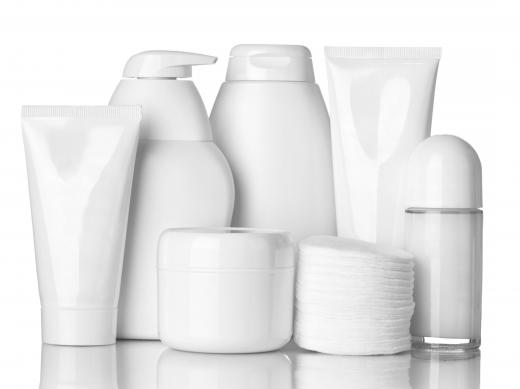What Are the Uses of DMDM Hydantoin?
Dimethylol dimethyl hydantoin (DMDM hydantoin), is a common preservative ingredient found in cosmetics production, construction materials, and household products. The chemical compound is typically added to products in minute quantities as an antimicrobial agent. Certain consumer advocates fear that when combined with other chemicals, the substance may cause cancer. Some individuals may develop skin irritations while using topical products containing this chemical formulation.
Other names for the compound include 1,2-demithylol-5,5 dimethyl hydantoin and dimethyl-2,4-imidazolidinedione. DMDM hydantoin is generally an organic compound that prevents bacterial, fungal, and viral development. By regulation standards, products usually contain only 0.1% to 0.6% of the substance. Different physical forms of the compound include a colorless liquid, a crystalline powder, or white to grey colored flakes. The compound consists of dimethyl hydantoin and formaldehyde.

Common cosmetic products containing DMDM hydantoin include hair conditioners, gels, and shampoos. Manufacturers also frequently use the substance in cream and lotion-type skin care products. Many industries incorporate the compound for its fungal and mold resistant properties. The substance might accompany ingredients used for adhesives, inks, and latex paints. Herbicides, paper, and photography supplies commonly contain this ingredient.

In addition to DMDM hydantoin, some cosmetic compounds may contain dimethicone, methylparaben, and formaldehyde. Dimethicone is an oily emollient used for skin softening. Methylparaben and formaldehyde are also antimicrobial preservatives. Formaldehyde, or CH2O, is a known carcinogen. Other names for the chemical are formalin, methyl aldehyde, morbicid acid, and oxymethylene.

DMDM hydantoin, and similar substances that include diazolidynyl urea and quarternium-15, draw concern from consumer protection specialists because they have the ability to release formaldehyde. Advocates believe this reaction occurs continuously and slowly, regardless of environmental factors. The formaldehyde then reverts into a pungent, harmful gas. Industrialists claim that formaldehyde release only occurs when ingredients undergo high temperature exposure. Federal regulatory agencies limit the amount of formaldehyde releasing agents products may contain, but environmentalists argue that there are no limitations on these potentially harmful chemical reactions.

Some individuals develop allergic skin reactions when exposed to this preservative. These irritations typically appear as eczema or contact dermatitis. The chemical substance is generally easily removed from the skin by washing with soap and water. Health care providers suggest that once irritation occurs, individuals abstain from using products containing this ingredient. DMDM hydantoin is known to possess irritant properties and chemical workers can develop eye, skin, and lung irritations when working with the substance in large quantities.
AS FEATURED ON:
AS FEATURED ON:


















Discussion Comments
I always consider what I learned in Environmental Psych in college: the concept of "Clinical Ecology" --the idea is that if your toiletry products contain only 1/10th of 1% of a chemical preservative, then that doesn't sound too bad. BUT when you consider the total load of all the cosmetics, lotions, deodorant/perfume, hair products, as well as chemical cleaning products, air fresheners, etc., we use in our homes, then there may be a significant level of chemical load on our bodies. Something to consider, especially with the higher incidence of cancer these days.
It always leads me back to, "Better safe than sorry," so that more & more often I'm going for natural, preservative-free products and using good old dish soap to clean around the house (floors, tubs, sinks, fixtures--it gets your pots shiny, doesn't it?).
@MissDaphne - Deep breath! Look around. Most of look all right, yes? So we haven't been poisoned by our shampoo yet.
First, here's the thing about the urine - it's where toxins are *supposed* to go. It means that your kidneys filtered it just like they should.
Yeah, there are some gross chemicals out there. You can seek lower-chemical products at health food stores or nicer grocery stores (my Wegman's for instance, has a nice natural section). Some things you can even make yourself. Or you can take the step I take - I realized that I only really need to wash my hair every other day. Just like that, I have reduced my shampoo-related chemical exposure by 50%!
You can also find websites that rate cosmetics and personal care items by their chemical composition and the toxicity of those chemicals. The one I use is called HealthyStuff. Look at it occasionally if you're in the market for a new hand lotion or whatever, but in general, try not to worry so much!
Cosmetics seriously contain * formaldehyde*? Isn't that incredibly toxic? I keep reading that hundred of chemicals are found in the urine of babies, pregnant women, you name it. BPA in canned goods, who knows what in my shampoo - how can a mom protect herself and her family?
Post your comments